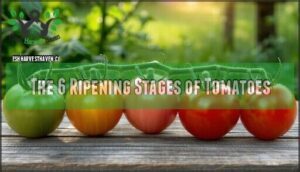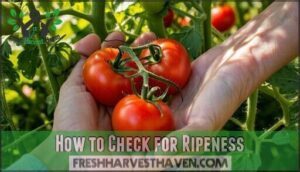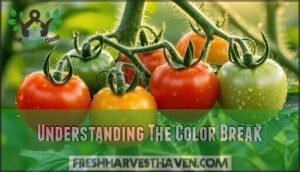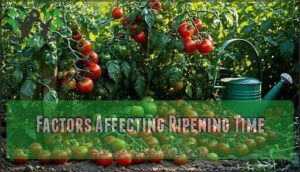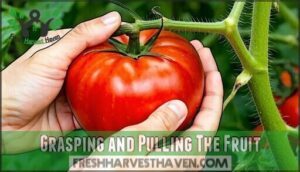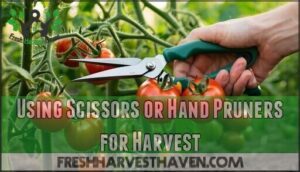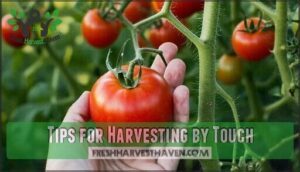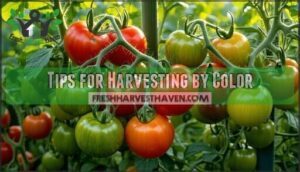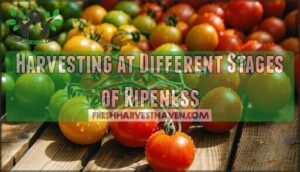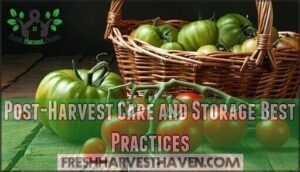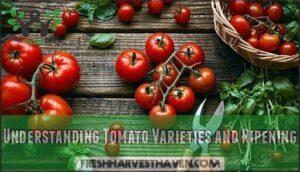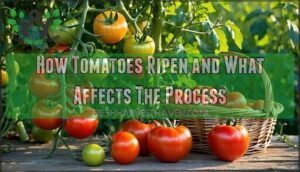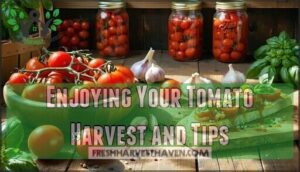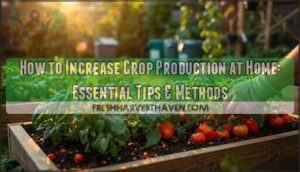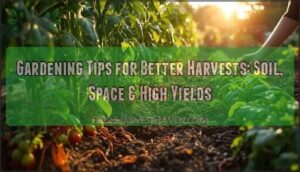This site is supported by our readers. We may earn a commission, at no cost to you, if you purchase through links.

They’ll ripen perfectly indoors at room temperature, developing better taste than vine-ripened fruit in hot weather. During peak season, harvest every day or two to prevent overripening.
Use a gentle twist-and-pull motion, or snip with clean scissors for delicate varieties. Store ripe tomatoes on your counter, never in the fridge, which kills their flavor compounds.
The secret lies in understanding exactly when each variety reaches its ideal harvest window.
Table Of Contents
- Key Takeaways
- Identifying The Right Time to Harvest
- Harvesting Techniques for Best Flavor
- Harvesting at Different Stages of Ripeness
- Post-Harvest Care and Storage Best Practices
- Understanding Tomato Varieties and Ripening
- How Tomatoes Ripen and What Affects The Process
- Enjoying Your Tomato Harvest and Tips
- Troubleshooting Common Issues and Concerns
- Frequently Asked Questions (FAQs)
- How do I choose the best tomato harvest time?
- How can i Improve my tomato harvest?
- How often should you harvest Tomatoes?
- How do you harvest a tomato?
- When should Tomatoes be harvested?
- How do you pick a tomato?
- What are the 5 tomato grow mistakes to avoid?
- What does Epsom salt do to tomatoes?
- What is the best way to store tomatoes after picking?
- Should you pick tomatoes as soon as they turn red?
- Conclusion
Key Takeaways
- Harvest at the breaker stage – Pick tomatoes when they show their first blush of color change from green, allowing them to ripen perfectly indoors while developing better flavor than vine-ripened fruit in hot weather.
- Check plants daily during peak season – You’ll prevent overripening and maximize yield by harvesting every 1-2 days when tomatoes are actively producing.
- Store at room temperature, never refrigerate – Keep ripe tomatoes on your counter stem-side down to preserve flavor compounds that cold temperatures destroy, maintaining peak taste for 4-7 days.
- Use proper harvesting technique – Support the fruit while cutting stems with clean scissors or use a gentle twist-and-pull motion to avoid bruising and plant damage.
Identifying The Right Time to Harvest
You’ll know your tomatoes are ready when they show the first signs of color change at the base, called "color break," which signals the start of ripening.
Timing this harvest correctly guarantees you get the best flavor and texture from your homegrown tomatoes.
The 6 Ripening Stages of Tomatoes
Understanding tomato ripening stages helps you harvest at peak flavor and quality.
Each stage brings distinct Color Development and Texture Changes that signal readiness:
- Mature Green: Full-sized but green, with firm texture and no Ethylene Production
- Breaker Stage: First color appears at blossom end, ethylene begins activating ripening
- Turning/Pink: 30-60% colored with slight softening and developing Flavor Profiles
- Red Ripe: 90%+ colored, soft texture, peak flavor from complete ripening process
Harvesting during the breaker tomato stage allows control over the final ripening.
How to Check for Ripeness
When checking for tomato ripeness, perform the Firmness Test by gently squeezing—ripe tomatoes should yield slightly while maintaining structure.
Look for Color Indicators like uniform hue development from bottom to stem, avoiding green shoulders.
The Mature Green stage shows full size with initial color changes.
Taste Testing confirms flavor development, while Ethylene Release signals active ripening.
Check tomato color consistency and tomato firmness together for reliable ripeness signs.
Understanding The Color Break
The color break marks your tomato’s pivotal moment when ethylene production triggers ripening initiation. This first blush of color—whether pink, yellow, or orange—signals that nature’s transformation has begun, and there’s no stopping it now.
Visual cues during this stage duration help you master tomato harvesting timing. The ripening uniformity spreads from the blossom end upward, creating the ripeness signs you’ll recognize with practice.
Here’s what signals the tomato color break:
- Green skin develops its first hint of mature color near the bottom
- Tomato color maturity progresses steadily upward toward the stem
- Green shoulders gradually fade as pigments spread evenly
- Uniform coloring indicates you’re approaching harvest-ready fruit
This color break phase represents the beginning of serious tomato harvesting best practices. You’ll notice the fruit feels slightly different too—still firm, but with a subtle shift in texture that experienced gardeners learn to recognize by touch. Consider that tomatoes ripen off-vine if picked at this stage.
Factors Affecting Ripening Time
Several factors substantially impact your tomato ripening process. Temperature influence proves vital—fruits ripen best between 70-85°F, while ripening stages slow dramatically above 86°F or below 60°F.
Sunlight exposure accelerates development, but watering practices and soil nutrients must stay balanced to avoid disrupting ethylene gas production.
Variety differences create unique timelines, so you’ll need to adjust expectations accordingly. Monitor these elements closely for ideal harvest timing.
Harvesting Techniques for Best Flavor
Once you’ve identified the perfect ripeness level, proper harvesting technique becomes essential for preserving that peak flavor you’ve worked so hard to achieve.
Whether you choose to gently twist and pull or use clean cutting tools, the way you harvest your tomatoes directly impacts their taste and storage life.
Grasping and Pulling The Fruit
When picking tomatoes, gentle grasping protects both fruit and plant from damage.
Follow these essential tomato harvesting techniques for perfect results:
- Support the branch while grasping the tomato firmly but gently
- Apply steady pressure without squeezing to prevent avoiding bruising
- Use a twisting motion at the stem for natural calyx detachment
- Pull with controlled force until you achieve a clean stalk break
- Check for clean separation to confirm successful firm pulling
This picking tomatoes method guarantees ripe tomatoes maintain their quality and flavor while keeping plants healthy for continued production.
Using Scissors or Hand Pruners for Harvest
In the context of smooth, clean cuts in the garden, reaching for pruning shears or sharp scissors can make your tomato harvesting a dream.
This method boosts labor efficiency, and it also keeps stem scarring and bruising at bay—a win for flavor and shelf life. Proper tomato harvesting tools and techniques lead to less plant stress and more ripe tomatoes on your plate.
Before you snip, remember: tool maintenance is your backstage pass to healthy plants. Selecting the right garden pruning shears guarantees clean cuts.
Here’s your simple four-step approach to smarter harvesting:
- Pick ergonomic, sharp tools: Choose pruning or garden shears that suit your grip and stay sharp for the season.
- Support the fruit gently: Use your free hand for gentle support.
- Snip just above the calyx: Clip 1/4 inch above the green top for tidy results.
- Handle with care: Respect the tomato’s soft skin—less bruising means longer-lasting flavor.
Tips for Harvesting by Touch
After you’ve snipped your tomato off the vine with scissors or pruners, don’t just trust your eyes—let your fingertips be the judge.
Gently squeeze the fruit to check for Bounce Back and ideal Skin Texture. Ripe tomatoes should feel tender but not mushy, signaling prime tomato ripeness.
Remember that softness indicates ripeness, regardless of color. These Tactile Indicators help you avoid underripe and overripe picks.
- Try the gentle squeeze test for precise Firmness Levels.
- Trust tomato texture over color alone.
- A ripe tomato will feel heavier for its size—sweet reward in every grip!
Tips for Harvesting by Color
When harvesting tomatoes, you’ll rely on color as your primary guide to perfect ripeness.
The "color break" at the blossom end signals the start of the Breaker Stage, when tomatoes begin their transformation from green to their varietal color.
| Stage | Color Indicators | Harvest Timing |
|---|---|---|
| Green Stage | Solid green, no color break | Wait unless weather threatens |
| Breaker Stage | First blush of pink/red | Ideal for storage and ripening |
| Pink Stage | 30-60% color development | Good balance of flavor and shelf life |
Monitor for two-thirds color change across the fruit’s surface for ideal tomato harvesting.
Different varieties display unique varietal colors—yellow ‘Sungold’ or deep red beefsteaks each signal readiness differently.
Focus on uniform color development and glossy skin texture when determining tomato ripeness, as these visual cues guarantee flavorful ripe tomatoes with excellent shelf life.
Harvesting at Different Stages of Ripeness
You can harvest tomatoes at several stages depending on your needs, from the breaker stage when they first show color to full ripeness on the vine.
Each stage offers different benefits, whether you’re looking to extend storage time, prevent cracking, or maximize flavor.
You can use these stages to your advantage, depending on what you want to achieve with your tomato harvest.
Harvesting at The Breaker Stage
Your tomato’s first blush of color marks the breaker stage—that perfect moment when harvesting pays off big time.
That first blush of color signals nature’s sweetest transformation has begun.
This early harvest strategy protects your crop while maximizing both flavor development and market value. You’ll spot the telltale signs: a soft yellow or pink tinge appearing at the base, signaling the fruit has absorbed all essential nutrients from the vine.
Smart harvesting at this stage delivers impressive results:
- Extending shelf life by up to two weeks compared to fully ripe fruit
- Reducing damage from pests, weather, and handling during transport
- Improving ripening consistency through controlled indoor conditions
- Maintaining peak flavor as natural processes continue off the vine
Handle each tomato gently when picking to prevent bruising. Specialized tools, like tomato harvesting knives, can further streamline the process.
The breaker stage gives you control over the final ripening process while preserving that garden-fresh taste you’ve worked so hard to achieve.
Harvesting at The Turning or Pink Stage
Many experienced gardeners prefer the turning stage for its perfect balance of flavor development and extended shelf-life.
At this stage, your tomatoes show 50-75% pink coloration while maintaining prime firmness for handling and storage.
This timing offers significant turning stage benefits, including reduced pink stage risks like cracking and pest damage.
Some gardeners also use specialized tools to assist with turning stage harvesting.
Watch for these ripening consistency indicators:
- Color progression: Notice the pink hue spreading from the base upward
- Texture test: Gentle pressure reveals slight give without mushiness
- Stem area: Pink coloration appears near the shoulders
Your tomato harvesting at this stage guarantees excellent tomato flavor while extending storage time.
These harvesting tips help you capture peak tomato ripening without sacrificing quality or shelf-life.
Harvesting at The Fully Ripe Stage
Nothing beats the satisfaction of biting into a perfectly ripe tomato you’ve grown yourself.
There’s no greater reward than that first bite of a sun-warmed tomato, fresh from your own garden.
When you harvest at the fully ripe stage, you’re rewarded with superior flavor and peak sweetness that store-bought varieties simply can’t match. However, timing is everything—these delicate beauties have increased bruising risk and require immediate use for spoilage prevention.
Consider that darker shoulders indicate ripeness in colorful varieties.
Here’s your roadmap to tomato harvesting perfection:
- Squeeze gently: Ripe tomatoes yield slightly but remain firm
- Check mature color: Deep, uniform hue from stem to bottom
- Feel the texture: Smooth, taut skin without wrinkles
- Smell the stem: Sweet, earthy aroma indicates best time harvest
Harvesting for Specific Uses
Your harvest strategy should match your intended use. For Fresh Eating, pick tomatoes when they’re 90% colored but still firm—this gives you maximum flavor while maintaining good texture for salads and sandwiches.
Sauce Tomatoes like Roma varieties work best when harvested at the red stage, providing concentrated flavor and lower moisture content that’s perfect for cooking down.
Canning Tomatoes require blemish-free, crack-free fruit to guarantee safe preservation and consistent results. If you’re planning Seed Saving, let fruits ripen fully on the vine before harvesting—this guarantees viable seeds for next season’s garden.
Green Tomatoes harvested at the mature green stage offer excellent shelf life and work wonderfully in fried dishes or pickles. For tomato storage, breaker stage harvesting extends freshness while maintaining tomato flavor.
These harvesting tips help you maximize your ripe tomatoes based on your specific needs, guaranteeing tomato harvesting success every time.
Post-Harvest Care and Storage Best Practices
Once you’ve harvested your tomatoes, proper storage determines how long you’ll enjoy their peak flavor and texture.
The key is understanding that different ripeness levels require different storage approaches to maximize your harvest’s quality and shelf life.
Storing Ripe Tomatoes at Room Temperature
Once you’ve harvested your tomatoes at the perfect ripeness level, proper storage makes all the difference in maintaining their flavor and extending tomato shelf life.
Room temperature storage beats refrigeration every time for preserving that garden-fresh taste you’ve worked so hard to achieve.
Here’s how to master countertop storage for your ripe tomatoes:
- Position them stem-side down on a flat surface to prevent moisture loss and maintain ideal airflow around each fruit.
- Keep away from direct sunlight exposure by choosing a cool, shaded spot between 65-75°F for consistent storage duration.
- Use breathable containers like shallow baskets or open bowls to promote air circulation and prevent condensation buildup.
This tomato room temperature storage method preserves flavor compounds that refrigeration destroys, keeping your harvest at peak quality for 4-7 days.
Avoiding Refrigeration for Optimal Flavor
Refrigeration destroys tomato flavor and creates mealy texture, making your harvest taste bland and disappointing.
Cold temperatures halt ripening and break down cell walls, ruining what should be juicy, flavorful fruit.
Store tomatoes at room temperature instead for ideal flavor preservation and natural ripening continuation.
Storage Method Impact on Flavor Texture Quality Ripening Impact
Storing Tomatoes on a Windowsill or Countertop
With your ripe tomatoes safely away from the refrigerator, proper countertop placement becomes your next priority for maintaining ideal ripeness and extending shelf life. Position them stem-side down on a stable surface where they won’t roll or get knocked over during daily kitchen activities.
Choose a spot with gentle sunlight exposure to encourage any remaining ripening while showcasing their visual appeal. Your kitchen counter or windowsill works perfectly for tomato storage tips that actually deliver results.
- Ensure adequate air circulation around each tomato to prevent moisture buildup and bacterial growth
- Use shallow containers or baskets that allow airflow underneath for better tomato postharvest care
- Avoid stacking multiple layers, which can cause bruising and reduce shelf life substantially
- Rotate daily if using a windowsill to promote even tomato ripening on all sides
- Keep away from heat sources like stoves or direct afternoon sun that accelerates spoilage
This simple tomato harvesting approach keeps your ripe tomatoes fresh for several days while adding natural beauty to your kitchen space.
Options for Long-Term Storage
When countertop ripening meets your harvest’s full potential, tomato preservation becomes your best friend for year-round enjoyment.
Transform your bumper crop into pantry treasures with these proven tomato storage solutions:
- Freezing methods: Blanch whole tomatoes, slip off skins, and freeze in portions for up to 12 months. Perfect for tomato sauce and winter soups when you’re craving that summer flavor.
- Canning tomatoes: Process in sterilized jars with proper acidification for shelf-stable storage lasting 1-2 years. Your future self will thank you during January’s cold snap.
- Drying techniques: Create intensely flavored dried tomatoes using dehydrators or ovens. Store in olive oil for enhanced taste, but guarantee complete dryness to prevent spoilage.
Consider fermented tomatoes for unique flavors, or combine multiple tomato preservation methods for maximum flexibility throughout the seasons.
Understanding Tomato Varieties and Ripening
Different tomato varieties ripen at different paces and require specific harvesting approaches to maximize flavor and texture.
You’ll need to adjust your timing and technique based on whether you’re growing heirlooms, cherry types, sauce varieties, or standard slicing tomatoes.
Heirloom Tomatoes and Harvesting
Now that you understand proper storage, heirloom tomatoes require special attention during harvest. These living heirlooms offer unique flavors and variety differences that make them garden treasures worth the extra care.
Heirloom tomatoes present ripening challenges due to their heirloom softness and delicate nature. They progress through distinct stages, so watch for the first blush of color at the bottom—your signal they’re ready. Unlike hybrids, these varieties ripen unevenly and bruise easily.
Here’s your harvesting guide:
| Stage | Color Change | Firmness | Best Use |
|---|---|---|---|
| Breaker | 10-30% color | Firm | Indoor ripening |
| Turning | 30-60% color | Slightly soft | Fresh eating soon |
| Pink | 60-90% color | Soft | Immediate use |
| Ripe | Full color | Very soft | Sauce, seed saving |
| Overripe | Deep color | Mushy | Cooking only |
Use scissors rather than pulling—tomato harvesting techniques matter more with heirlooms. Cut stems cleanly while supporting the fruit’s weight. Morning harvests preserve tomato quality when temperatures are cooler.
Handle these beauties like eggs. Their thin skins can’t take rough treatment, but their tomato flavor rewards your gentle touch.
Cherry Tomatoes and Harvesting
Cherry tomatoes present unique harvesting challenges that set them apart from their larger cousins. These bite-sized gems ripen faster than larger varieties, making daily monitoring essential for tomato harvesting best practices.
Cracking Prevention and Rotting Prevention depend on perfect timing:
- Check for complete color development with Flavor Differences peaking at 90% ripeness
- Harvest during cool mornings using tomato harvesting techniques with sharp scissors
- Practice Small Batching by collecting ripe fruits daily to prevent vine splitting
- Follow Ripening Order by picking clusters as individual tomatoes reach peak color
- Handle gently to preserve delicate skin and maximize tomato flavor
Cherry tomatoes deliver their sweetest taste when fully vine-ripened, unlike larger varieties that can ripen off the plant. To maintain freshness, consider morning harvest timing. Your daily harvest routine guarantees you’ll capture each fruit at its flavor peak while preventing overripe splitting that wastes your precious crop.
Roma and Sauce Tomatoes and Harvesting
Roma and sauce tomatoes require patience for ideal tomato harvesting best practices, as their concentrated flavor develops differently than fresh varieties.
Roma tomatoes shine when you harvest them at peak ripeness for maximum sauce tomato yield. These paste tomato varieties concentrate their sugars and flavors only when fully mature, making timing critical for your tomato sauce projects.
Roma Ripeness and Harvesting Techniques:
- Wait for complete color transformation – Roma ripeness occurs when the entire fruit displays uniform red coloring without green shoulders, indicating maximum sugar content for processing methods
- Harvest during cool mornings – Pick when plants are hydrated but surfaces are dry to prevent bacterial contamination and maintain paste tomato care standards
- Use clean cutting tools – Sharp shears prevent plant damage and guarantee clean stem cuts, protecting your investment in these productive determinate varieties
These tomato varieties typically ripen within concentrated timeframes, perfect for large-batch canning sessions. Their thick, meaty flesh contains less water and more pulp than slicing varieties, delivering that rich consistency you want for sauces and pastes.
Beefsteak, Red Slicing, and Hybrid Tomatoes and Harvesting
Beefsteak tomatoes are the heavyweight champions of the tomato world, requiring a different harvesting approach than their smaller cousins.
These giants develop beefsteak size slowly, so patience pays off when timing your harvest.
Watch for the red color to cover about 75% of the fruit’s surface—this indicates peak flavor development.
Beefsteak tomatoes should feel heavy and yield slightly to gentle pressure while maintaining their slicing texture.
Don’t wait for complete redness; they’ll continue ripening off the vine.
Hybrid tomatoes showcase impressive hybrid vigor, often producing consistently sized fruits with predictable ripening patterns.
However, varietal differences mean you’ll need to adjust your tomato harvesting approach based on your specific variety.
| Tomato Type | Harvest Indicator | Tomato Harvesting Tips |
|---|---|---|
| Beefsteak | 75% red color, slight give | Support fruit when cutting |
| Red Slicing | Uniform red, firm texture | Harvest before full softness |
| Hybrid | Variety-specific color | Follow seed packet guidelines |
Master these harvesting techniques and you’ll enjoy perfect slicing tomatoes every time.
How Tomatoes Ripen and What Affects The Process
Understanding how tomatoes ripen helps you harvest at the perfect moment for maximum flavor and quality.
The ripening process involves complex chemical changes driven by ethylene gas, temperature, and variety-specific factors that you can influence to get better results.
The Role of Ethylene in Ripening
Behind every tomato’s transformation from green to red lies ethylene gas, nature’s ripening switch that you can learn to work with.
This invisible hormone kicks into high gear when your tomatoes hit the breaker stage, launching a biochemical symphony that creates the flavors you love. Ethylene production increases 100 to 300 times during this climacteric fruit stage, making tomato ripening an autocatalytic process that feeds on itself.
Here’s what ethylene does for your harvest:
- Breaks down chlorophyll while building lycopene for vibrant color change
- Activates enzymes that soften fruit texture through pectin degradation
- Triggers sugar accumulation and organic acid balance for flavor development
- Controls aroma compounds that give tomatoes their distinctive smell
Ripening speed depends on temperature and ethylene concentration – warmer conditions accelerate the process. Understanding these storage effects helps you time harvests perfectly, whether you want tomatoes for immediate use or extended shelf life. For maximum sweetness, remember that cherry tomatoes need attention.
How Tomatoes Ripen From The Inside-Out
Understanding ripening reveals nature’s intricate cellular processes at work.
Tomato ripening begins internally when ethylene production triggers enzymatic changes, transforming white flesh to pink before external color appears.
These ripening hormones initiate nutrient transport throughout the fruit while pigment development creates the signature red hue from within.
The tomato ripening process involves complex cell wall modifications as acids convert to sugars, developing rich flavors.
This inside-out transformation explains why tomato maturity indicators focus on internal changes rather than surface appearance.
Understanding these tomato flavor enhancement mechanisms helps you recognize ideal tomato harvesting techniques timing, since what’s happening beneath the skin determines peak ripeness and maximum taste potential.
Factors Affecting Ripening Time and Quality
Several key factors determine how quickly and well your tomatoes ripen. Temperature Effects play the biggest role—your tomatoes need that sweet spot between 70-75°F for ideal tomato ripening. When temperatures soar above 90°F, the process stalls completely, while cooler weather slows things down.
Sunlight Exposure and Watering Practices work together to develop proper tomato flavor and prevent common problems. Here’s what affects your tomato maturity:
- Temperature fluctuations above 90°F halt the ripening process entirely
- Consistent Sunlight Exposure affects color development and sugar content
- Soil Nutrients, particularly potassium levels, prevent ripening problems
- Variety Differences determine natural ripening speed and tomato harvesting timing
- Proper Watering Practices guarantee even, crack-free fruit quality
Balance these factors for better harvesting techniques and superior tomato flavor.
Tips for Enhancing Ripening
You can accelerate tomato ripening with strategic techniques that work with natural processes.
Reduce watering as fruits mature—this stress signals plants to focus energy on ripening process rather than new growth.
Temperature Control matters too; maintain soil temps between 65-75°F for ideal ethylene gas production.
Ethylene Exposure tricks boost results:
ripening
ethylene gas
ripening on track
Variety Differences affect timing—cherry tomatoes respond faster than beefsteaks.
For indoor ripening, place green tomatoes with apples in paper bags.
Light Exposure and Humidity Levels around 85% create ideal conditions.
These harvesting techniques preserve flavor preservation while speeding maturation.
Enjoying Your Tomato Harvest and Tips
Once you’ve mastered the art of harvesting tomatoes at their peak ripeness, you’ll want to make the most of your homegrown bounty.
The real joy comes from transforming your fresh harvest into delicious meals, preserving the flavors for months to come, and discovering new ways to showcase different tomato varieties in your kitchen, which is the key to enjoying your homegrown bounty.
Using Fresh Tomatoes in Recipes
Once you’ve mastered harvesting timing, transform your garden’s bounty into culinary masterpieces that’ll make your taste buds dance.
Fresh tomatoes shine brightest when you use them within days of picking, letting their natural sweetness and acidity create flavor magic in your kitchen.
Here’s how to make the most of your harvest:
- Tomato Salads – Slice ripe beauties with fresh basil and mozzarella for a summer symphony
- Fresh Salsas – Dice tomatoes with onions, cilantro, and lime for zesty perfection
- Tomato Bruschetta – Top crusty bread with herb-kissed tomato mixtures for elegant appetizers
- Tomato Soups – Simmer fresh tomatoes into velvety comfort food that warms the soul
Your tomato recipes will taste infinitely better when you use fruit picked at peak ripeness.
Roasting Tomatoes for Enhanced Flavor
Anyone can turn their freshly harvested tomatoes into rich, caramelized gems through simple roasting techniques. This method concentrates natural sugars while deepening flavor profiles, creating versatile ingredients for countless tomato recipes.
Roasting Techniques for Maximum Flavor Enhancement:
- Variety Selection: Choose firm, fully ripe tomatoes – cherry varieties work beautifully alongside beefsteak for different textures and cooking times.
- Temperature Control: Roast at 400-425°F for 35-40 minutes, watching for golden edges that signal perfect caramelization without burning.
- Seasoning Strategy: Drizzle with olive oil, sprinkle coarse salt, and add fresh herbs like rosemary or thyme before roasting.
- Storage Roasting: Roasted tomatoes keep refrigerated for one week, making them perfect for meal prep and recipe ideas throughout your harvest season.
Preserving Tomatoes Through Canning, Freezing, or Drying
Beyond enjoying fresh tomatoes, preserving your harvest extends summer’s flavors year-round.
Canning methods require disease-free, vine-ripened fruit plus acidification—add 2 tablespoons bottled lemon juice per quart for safety. Both boiling water bath and pressure canning work effectively.
Freezing tomatoes offers the simplest approach: blanch, peel, and store in airtight containers. Thawed tomatoes peel effortlessly and work perfectly in cooked dishes.
Drying techniques concentrate sweetness—slice tomatoes 1/2 inch thick, then use a dehydrator at 140°F for 8-10 hours or oven at 200°F for 10-12 hours until leathery.
Choose your preservation method based on intended use: canning for shelf-stable sauces, freezing for cooking ingredients, drying for intense flavor additions. Storage safety requires proper acidification for canning and complete dehydration for dried tomatoes.
Experimenting With Different Varieties and Techniques
Your tomato garden becomes a living laboratory when you experiment with different varieties and harvesting techniques.
Each tomato variety has unique Variety Ripening Times and Technique Flavor Impact, making variety differences vital for harvesting best practices.
- Test Climate Variety Pairing – Match heat-loving varieties with your local growing conditions for maximum tomato harvesting success.
- Practice Soil Experimentation – Adjust pH and nutrients for specific tomato varieties to enhance flavor development and harvest timing.
- Try Grafting for Harvest – Combine disease-resistant rootstock with flavorful varieties to extend your harvesting season and improve yields.
Troubleshooting Common Issues and Concerns
Even experienced gardeners encounter challenges when harvesting tomatoes, from cracking fruit to pest problems that can reduce your yield.
Learning to identify and prevent these common issues will help you maximize your harvest and enjoy the best-tasting tomatoes from your garden.
Avoiding Overripe or Damaged Fruit
Daily inspections are your first line of defense against overripe tomatoes and tomato damage. Check for firmness—ripe fruit should yield slightly to gentle pressure.
Use timely picking strategies by harvesting when tomatoes show first color changes rather than waiting for full ripeness. Practice gentle handling and bruising prevention by supporting the fruit while cutting stems with clean scissors.
Regular checks help you catch problems early. Proper fruit handling during harvest protects your crop, while smart storage methods preserve quality longer.
Preventing Cracking and Splitting
Cracking and splitting happen when your tomatoes grow faster than their skin can handle, usually from inconsistent watering practices. You’ll see this especially after dry spells followed by heavy rain or overwatering.
Keep soil moisture steady with 1-2 inches weekly rather than letting plants go thirsty then drowning them. Calcium deficiency weakens tomato skin, making splitting worse, so test your soil and amend as needed. Temperature fluctuations stress plants and contribute to cracking too.
Smart prevention strategies include:
- Mulch heavily – Apply 2-3 inches around plants to buffer soil moisture and temperature changes
- Choose crack-resistant varieties – Select tomatoes bred specifically for tough skins that handle stress better
- Time your harvest – Pick nearly-ripe fruits before storms to avoid rain-induced splitting
Watch for sunscald prevention by providing afternoon shade during heat waves. Container growing gives you better control over watering consistency than in-ground planting.
Managing Pests and Diseases
While preventing cracks matters, pest identification and disease prevention protect your entire crop investment.
Tomato pests like hornworms can destroy plants overnight, while tomato diseases spread rapidly in humid conditions.
Stay ahead with these strategies:
- Monitor weekly for insect damage and remove hornworms by hand or apply Bt spray for organic controls.
- Practice crop rotation every 2-3 years to break disease cycles and prevent tomato mildew buildup.
- Apply fungicides during wet weather and use chemical treatments when organic methods aren’t enough.
Tips for Maximizing Your Tomato Harvest
Building on solid pest management practices, you’ll want to optimize every aspect of your tomato harvesting approach to maximize yield and quality.
Smart harvesting strategies can boost your overall production:
- Time your harvest windows: Pick tomatoes every 2-3 days during peak season to encourage continued fruit development and prevent overripening losses.
- Implement strategic watering strategies: Water deeply but less frequently, stopping irrigation 24 hours before harvest to concentrate flavors and reduce splitting risks.
- Practice selective harvesting methods: Remove lower, shaded fruits first to redirect plant energy toward developing upper clusters, improving overall plant health and fruit quality.
These tomato harvesting best practices work together like a well-oiled machine. Your tomato harvest will thank you for the attention to detail, and your kitchen will reward you with superior flavor and extended storage life.
Frequently Asked Questions (FAQs)
How do I choose the best tomato harvest time?
Perfect picking presents itself when tomatoes show two-thirds color development from bottom up, feel firm yet yield slightly to gentle pressure, and display their variety’s mature hue.
Test one first for ideal flavor timing.
How can i Improve my tomato harvest?
You’ll boost your tomato harvest by timing picks perfectly—harvest when two-thirds colored.
Use morning hours, handle gently by shoulders, cut stems with sharp pruners, and store properly at room temperature to ensure the best results from your tomato harvest.
How often should you harvest Tomatoes?
You should harvest tomatoes every 2-3 days during peak season. Check plants daily, picking ripe ones to encourage continued production and prevent overripening or cracking on the vine.
How do you harvest a tomato?
When picking tomatoes, gently twist and lift them from the vine or use clean scissors to cut the stem.
Support the fruit while harvesting to prevent bruising, and handle by the shoulders rather than the stem end for best results, ensuring a gentle touch to avoid damage to the fruit.
When should Tomatoes be harvested?
You should harvest tomatoes when they’re firm but yielding to gentle pressure, with mature color development. Pick when two-thirds colored for best flavor, or at breaker stage for extended storage.
How do you pick a tomato?
Ready to pick like a pro?
Grasp the tomato gently near its shoulders, twist slightly, and pull upward with a smooth motion.
The stem should snap cleanly above the calyx, leaving your plant undamaged and ready for more harvests.
What are the 5 tomato grow mistakes to avoid?
Don’t overwater, avoid planting too deep, skip supporting tall varieties, ignore pruning suckers, and harvest too early – these mistakes sabotage your tomato success every season.
What does Epsom salt do to tomatoes?
Epsom salt gives your tomatoes a boost by providing magnesium and sulfur, which help them grow strong, lush, and green.
Just sprinkle a little around the base—too much, though, and you’ll invite more trouble than tomatoes.
What is the best way to store tomatoes after picking?
Why toss flavor away? Store ripe tomatoes stem-side down at room temperature, avoiding refrigeration which ruins taste. Use shallow, breathable containers for proper airflow, extending freshness for several days.
Should you pick tomatoes as soon as they turn red?
Don’t pick tomatoes immediately when they turn red. Wait until they’re two-thirds colored for ideal flavor, as they’ll continue developing taste and texture on the vine.
Conclusion
Like a garden’s grand finale, mastering harvesting tomatoes best practices transforms your homegrown treasures into culinary gold.
You’ve learned the perfect timing windows, proper techniques, and storage secrets that preserve peak flavor.
Remember to harvest at the breaker stage, store at room temperature, and check plants daily during peak season.
These harvesting tomatoes best practices guarantee you’ll enjoy the sweetest, most flavorful tomatoes from your garden all season long.
- https://www.thespruceeats.com/how-to-can-tomatoes-p2-2216509
- https://divascancook.com/how-to-freeze-tomatoes-no-blanching/
- https://extension.umn.edu/preserving-and-preparing/how-dry-tomatoes-home
- https://extension.usu.edu/yardandgarden/research/tomatoes-in-the-garden
- https://www.johnson.k-state.edu/lawn-garden/agent-articles/vegetables/harvest-ripen-tomatoes.html

